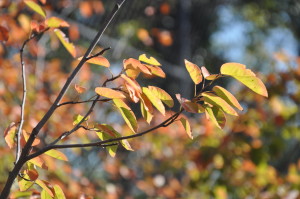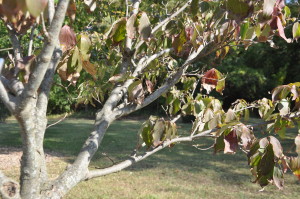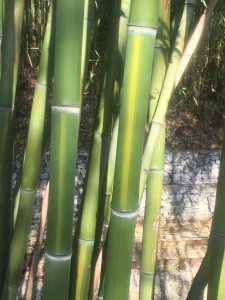Fall landscaping is a great opportunity to start preparing for spring! So, if you’ve been thinking of planting a tree but are not quite sure what to get, look no further than the Autumn Brilliance Serviceberry or the Aurora Dogwood, both of which you can scope out here at the Zoo!
 Autumn Brilliance Serviceberry (Amelanchier x grandiflora), is an excellent, small tree choice for your yard. It can be grown as a tree with a single stem or as a large multi-stem shrub. The bark is smooth and light gray. Its name correctly describes the tree’s outstanding red leaf color in the fall — but equally beautiful is the burst of white flowers presented in springtime. This springtime flowering is followed by the development of small, dark-colored berries that are edible for wildlife. Serviceberry trees reach approximately 20 to 25 feet tall and wide at maturity. They are tolerant of a wide range of soil types, but do best in a well-drained site with full to partial sunny areas. You can find this tree at the Zoo near the Jaguar exhibit.
Autumn Brilliance Serviceberry (Amelanchier x grandiflora), is an excellent, small tree choice for your yard. It can be grown as a tree with a single stem or as a large multi-stem shrub. The bark is smooth and light gray. Its name correctly describes the tree’s outstanding red leaf color in the fall — but equally beautiful is the burst of white flowers presented in springtime. This springtime flowering is followed by the development of small, dark-colored berries that are edible for wildlife. Serviceberry trees reach approximately 20 to 25 feet tall and wide at maturity. They are tolerant of a wide range of soil types, but do best in a well-drained site with full to partial sunny areas. You can find this tree at the Zoo near the Jaguar exhibit.
 The Aurora Dogwood (Cornus rutban) is a hybrid variety of dogwood that was propagated to be resilient to attacks by insect borers and the widespread fungal disease, Anthracnose, which is affecting dogwoods across the eastern U.S. This is a medium to fast growing deciduous tree that has a pyramidal shape and attains a size of 25 feet tall and 20 feet wide when mature. This tree bears copious amounts of large white flowers in mid-spring. The Aurora dogwood does best in moist, well drained soils, with 6–8 hours of sun and ideally some shade during the summer mid-day hours. You can view this tree at the Zoo in the grassy area across from the ropes course! Just look for the sign.
The Aurora Dogwood (Cornus rutban) is a hybrid variety of dogwood that was propagated to be resilient to attacks by insect borers and the widespread fungal disease, Anthracnose, which is affecting dogwoods across the eastern U.S. This is a medium to fast growing deciduous tree that has a pyramidal shape and attains a size of 25 feet tall and 20 feet wide when mature. This tree bears copious amounts of large white flowers in mid-spring. The Aurora dogwood does best in moist, well drained soils, with 6–8 hours of sun and ideally some shade during the summer mid-day hours. You can view this tree at the Zoo in the grassy area across from the ropes course! Just look for the sign.
 Though it may be tempting, if you’ve been considering increasing the privacy at your home with a plant instead of a fence, a plant to avoid using for this purpose is Yellow Groove bamboo (Phyllostachys aureosulcata). This plant is highly invasive, will spread and becomes firmly established very quickly. It is native to Asia and a very hardy species that is drought tolerant, pollution tolerant, and can cope with our worst winter weather. You can see this species of bamboo at the Louisville Zoo growing in Gorilla Forest and on the path to Islands. It definitely creates the feeling of being in a tropical ecosystem! However, the Louisville Zoo has a professional horticulture staff that is capable of managing the growth habits of this species. A good choice for a natural fence would be to plant Columnar Norway Spruce. You can see an example of this beautiful evergreen tree near Tiger Tundra!
Though it may be tempting, if you’ve been considering increasing the privacy at your home with a plant instead of a fence, a plant to avoid using for this purpose is Yellow Groove bamboo (Phyllostachys aureosulcata). This plant is highly invasive, will spread and becomes firmly established very quickly. It is native to Asia and a very hardy species that is drought tolerant, pollution tolerant, and can cope with our worst winter weather. You can see this species of bamboo at the Louisville Zoo growing in Gorilla Forest and on the path to Islands. It definitely creates the feeling of being in a tropical ecosystem! However, the Louisville Zoo has a professional horticulture staff that is capable of managing the growth habits of this species. A good choice for a natural fence would be to plant Columnar Norway Spruce. You can see an example of this beautiful evergreen tree near Tiger Tundra!
